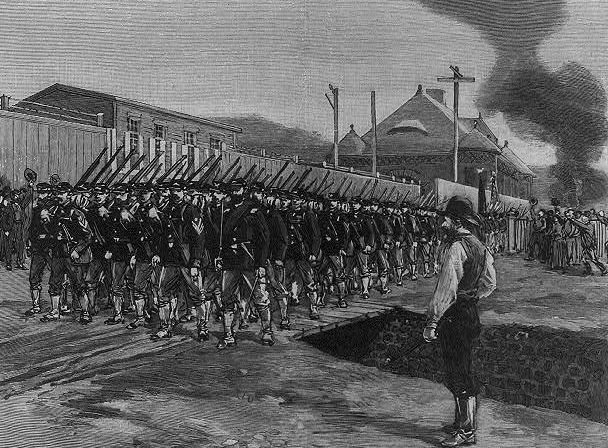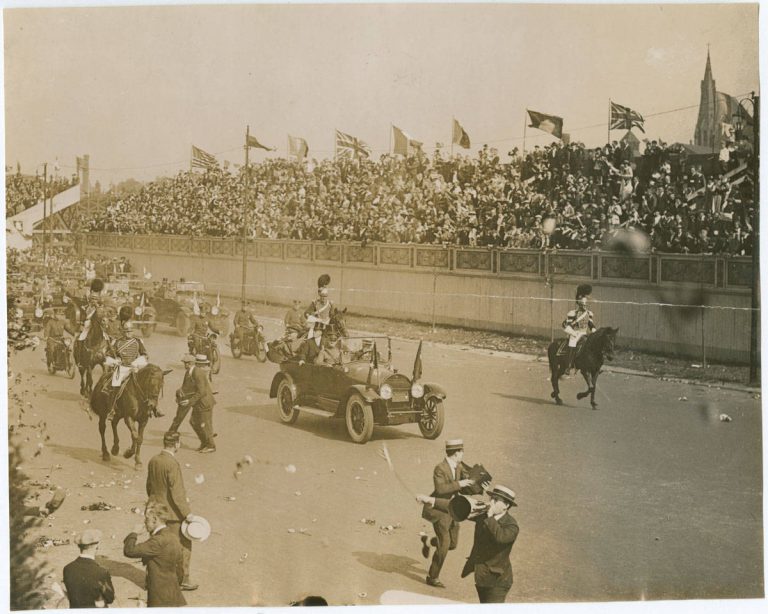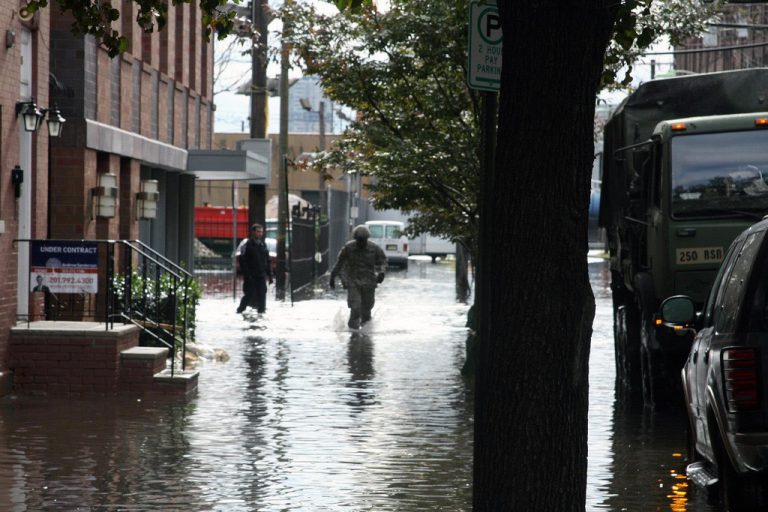National Guard
Essay
The roots of the National Guard can be traced to Philadelphia and congressional action during the city’s decade as the nation’s capital. The contributions and shortcomings of the colonial militia during the War of Independence, combined with cultural and political mistrust of standing military forces, spurred Congress to define how the United States would defend itself from foreign and domestic aggression. The result was the Militia Act of 1792, which standardized regulations for militia companies throughout the states. This act was the first in a series of developments that gradually led to the creation of the modern National Guard.
Volunteer militias formed and disbanded in the Philadelphia region throughout the nineteenth century as needed for domestic unrest and major military conflicts, including the War of 1812 and Mexican-American War. Following the Civil War, in 1870, the Pennsylvania militia companies formally changed their name to “The National Guard of Pennsylvania,” almost fifty years before the federal government adopted the term. Several prominent Philadelphia military organizations with lineages dating back to the Revolution became part of the statewide body, including the First Troop Philadelphia City Cavalry, Washington Grays of Philadelphia, and the Philadelphia “Associators.”
Similarly, New Jersey militia companies consolidated into state regiments that eventually folded into U.S. Army divisions. The 1st New Jersey Regiment, originally mustered for the Continental Army and revived during the Civil War, in 1869 became the “New Jersey National Guard,” which also encompassed the 3rd New Jersey Regiment from Burlington and Camden Counties. Delaware, despite the state’s small geographic size and population, had 564 organized militia companies in 1891, many of them with long lineages dating to the Revolutionary War and the War of 1812. Unlike Pennsylvania and New Jersey, Delaware’s militia companies remained independent throughout the eighteenth century.
The 1877 Railroad Strike
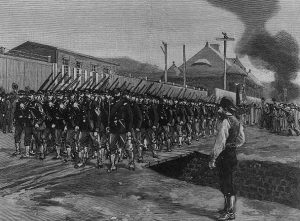
The first major mobilization of the Pennsylvania National Guard was not caused by trouble abroad but trouble at home and resulted in tragedy. In 1877, the Great Railroad Strike caused a massive labor stoppage and protests engulfed several major cities, including Philadelphia and Pittsburgh. After the Pittsburgh militia proved insubordinate to state orders to quell the unrest, Gov. John F. Hartranft (1830-89) ordered troops of the First Division of National Guard from Philadelphia to disperse a large crowd of protesters at Pittsburgh’s Pennsylvania Railroad Depot. Arriving on the scene on July 21, the outnumbered troops faced a crowd of more than twelve thousand strikers and sympathizers and the situation quickly deteriorated. As the guardsman advanced, the crowd did not back down, troops fired into the fray, and the violent clash killed twenty people. A full-scale riot ensued and drove the Philadelphians from the yard. It was up to the U.S. Army to finally restore order.
Philadelphia and the surrounding counties contributed several National Guard regiments to the U.S. Army during the Spanish-American War, the first major conflict in which the Pennsylvania, New Jersey, and Delaware National Guards were mustered for federal service. In total, fourteen regiments formed, including six from the Philadelphia area. The First Troop Philadelphia City Cavalry—once the personal guard for General George Washington (1732-99) and the oldest unit in the National Guard–reformed and joined two Philadelphia Volunteer Artillery Batteries and the Volunteer Infantry Regiments at camp near Lebanon, Pennsylvania. After the initial muster and drill, the majority remained state-side, but the 4th Pennsylvania Infantry saw action during the Puerto Rican campaign near Guayama in August 1898. Their only combat action was cut short by the announcement of the armistice on the same day.
Four New Jersey National Guard regiments were raised during the Spanish American War and were sent to camps in Florida, Georgia, and South Carolina in preparation for deployment in the Caribbean. Delaware also raised about five hundred troops in ten companies. The New Jersey and Delaware National Guard did not leave the United States, but nevertheless lost dozens of men to disease and accidents while encamped in southern states.
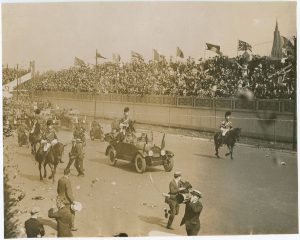
By the time of the Great War (1914-18), the federal Efficiency in Militia Act had created the modern National Guard system. Drawing upon prior militia legislation, the 1903 act sought to improve the efficiency, standardization, and armament of the National Guard; formalized the circumstances in which the National Guard could be federalized and deployed; and established the Corp of Reserve Officers.
World War I
Under the new law, National Guard units of New Jersey, Pennsylvania, and Delaware were called into federal service several times during the twentieth century. During the First World War, which gave the National Guard its first experience in intense direct combat, Philadelphia units consisting of the 111th Infantry Regiment (the “Associators”), the 104th Cavalry Regiment (the First Troop City Cavalry), and the 108th Field Artillery joined units from the Pittsburgh region to form the 28th Infantry Division. This division remained the designated unit for the Pennsylvania National Guard while under federal service throughout the twentieth century.
Modern warfare drastically reshaped roles on the battlefield for Philadelphia units with Revolutionary lineages. They created machine gun battalions, and the famed First Troop of the Philadelphia City Cavalry dismounted and joined the 103rd Trench Mortar Battery. The 28th Division, known as the “Keystone” division, arrived on the Western Front in France on May 31, 1918, and was quickly thrust into the Battle of Château-Thierry. After the Pennsylvanians repelled a German attack while suffering heavy losses, General John Pershing (1860-1948) referred to them as his “iron division.” Unlike the Spanish-American War, the Guard was not held in reserve and saw combat in the Meuse-Argonne, Champagne, and Marne campaigns. After 102 days on the front line and fourteen-thousand casualties, the 28th Division was relieved.
New Jersey National Guard regiments, along with elements from the Delaware National Guard, were assigned to the 29th Infantry Division. The 1st New Jersey Infantry and the 5th Delaware Infantry comprised the 114th Infantry Regiment and participated in the Meuse-Argonne Offensive in September 1918. Despite their relatively short time at the front, intense combat inflicted heavy casualties. By the time the 29th Division was pulled of the line. 5,570 men, more than 30 percent of the division, had been killed or wounded.
In keeping with the complex and expansive evolution of the United States military following the First World War, the National Guard continued to modernize and reorganize. Infantry regiments of the Pennsylvania National Guard were reassigned to engineering battalions and coastal artillery batteries, and New Jersey transferred several regiments into military police and reconnaissance. In 1933, the Pennsylvania National Guard Headquarters transferred from Philadelphia, its home since 1776, to the state capital in Harrisburg.
World War II
During the Second World War, National Guard units from the Delaware Valley returned to the fields of France. In Philadelphia, the 28th Infantry Division reformed for deployment to the European Theater, and several Philadelphia-based regiments returned to the Keystone Division, including the 108th Field Artillery Battalion. The 104th Cavalry Regiment, pulling troops from the First Troop of the Philadelphia City Cavalry, initially served stateside to provide security for the critical industrial areas around the Delaware. Similarly, the 111th Infantry Regiment of “Ben Franklin Associators” detached from the 28th Infantry Division to guard port facilities along the Eastern Seaboard.
Once deployed, the 28th Infantry Division fought in some of the most ferocious battles in France, including the breakout of Allied forces from Normandy. During the liberation of Paris in 1944, elements of the division famously paraded down the Champs Élysées. This revelry preceded the most vicious combat the Pennsylvania National Guard experienced, in the Battle of the Hurtgen Forest, where the 28th Division earned the nickname “the bloody bucket” in reference to its keystone-shaped insignia and heavy losses. After participating in the Battle of the Bulge and the Rhineland campaign, the division was pulled off the line after forty-one months in combat. Following the surrender of German forces, the division was deactivated from federal service in Harrisburg on November 20, 1945.
New Jersey National Guard regiments were assigned to the 44th Infantry Division during the Second World War. Originally conceived in 1920, the 44th Infantry Division was designed to receive New Jersey, Delaware, and New York National Guard regiments, but Delaware guardsman were never incorporated. The New Jersey 57th Infantry Brigade, consisting of the 114th and 113th Infantry Regiments, joined the 112th Field Artillery Regiment at Fort Dix and initially deployed to the Delaware River after the Japanese attack on Pearl Harbor. In September 1944, the 44th Infantry Division deployed to Europe, serving 190 days in combat and participating in campaigns in Central and Northern France, the Ardennes, and the Rhineland. The 44th suffered 6,111 battlefield casualties, earned three Distinguished Unit Citations, and accepted the surrender of famed rocket scientist Werner Von Braun.
Persian Gulf Conflicts
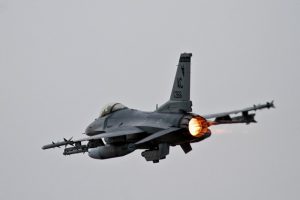
With the exception of single regiments and battalions, the Pennsylvania, New Jersey, and Delaware National Guard were not federalized during the Korean or Vietnam Wars. During the Persian Gulf War, Philadelphians from the 121st Transportation Company deployed to the Middle East, but the majority of Philadelphia regiments remained inactive on a federal level. The September 11, 2001, attacks and the invasion of Iraq in 2003 brought the Keystone division back into combat as regiments and combat brigades deployed in support of Operation Iraqi Freedom and Operation Enduring Freedom. Two of the oldest Philadelphian units, Ben Franklin’s “Associators” of the 111th Infantry Regiment and the First Troop Philadelphia City Cavalry of the 104th Cavalry Regiment deployed to Kuwait and Iraq as part of the Pennsylvania National Guard.
The 50th Combat Brigade of the New Jersey National Guard, under the 42nd Infantry Division, was deployed as part of the occupation of Iraq in 2008. From 2006 to 2013, the Delaware Army National Guard deployed several units in support of U.S. forces in Iraq and Afghanistan, including the 261st Theater Tactical Signal Brigade and the 72nd Troop Command Brigade. In conjunction with the National Guard State Partnership Program, units from the Delaware Valley have been sent to countries including Lithuania, Albania, Trinidad and Tobago, Jordan, Kuwait, and the United Arab Emirates to participate in joint training exercises and general ambassadorship
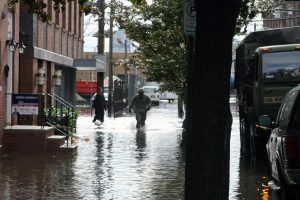
National Guard Units from the tristate area deployed stateside after major snowstorms, Hurricane Katrina, Hurricane Ivan, and Superstorm Sandy. The 114th Regiment of the New Jersey National Guard and the 112th Regiment of the Pennsylvania provided security for personnel of the Federal Emergency Management Agency (FEMA) in New Orleans in 2005. In February 2010, Delaware National Guard soldiers participated in “Operation Arctic Vengeance” and aided emergency management, fire, and police agencies during a blizzard. In the aftermath of Superstorm Sandy, New Jersey National Guard units aided in the rescue, evacuation, and resupply of devastated areas across the region.
In 2016, Pennsylvania, the third largest National Guard in the United States, had over seventeen thousand men and women in uniform. The New Jersey National Guard boasted troop strength of 6,025 soldiers, and Delaware’s National Guard troop strength was just under three thousand. The National Guard of the Delaware Valley remained a vital organization in both foreign service and local disaster relief and recovery.
William V. Bartleson is an independent scholar of military history who has worked with the New Jersey National Guard Militia Museum and the Center for Veterans Oral history. He is a member of Phi Alpha Theta. (Author information current at time of publication.)
Copyright 2016, Rutgers University
Gallery
Backgrounders
Connecting Headlines with History
- 2,000 Pa. National Guard troops assigned to storm response (WHYY, October 30, 2012)
- N.J. National Guard unit returns home (APP, July 1, 2014)
- NJ National Guard investigates claims of bias (WHYY, April 9, 2015)
- Delaware National Guard aids DNC security effort (WHYY, July 28, 2016)
- Philadelphia mounted unit taking part in Trump inaugural parade (WHYY, January 1, 2017)
